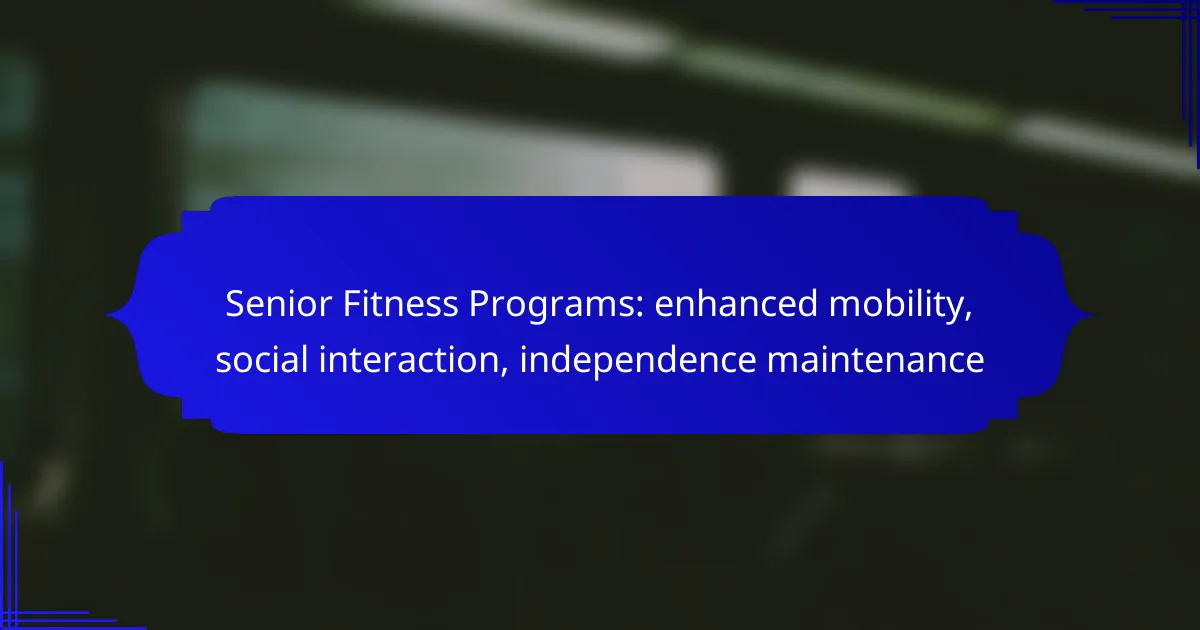Senior fitness programs are essential for enhancing mobility, promoting social interaction, and maintaining independence among older adults. By offering tailored activities that improve strength, flexibility, and balance, these programs empower seniors to perform daily tasks with greater ease. Additionally, the social aspect of these programs fosters motivation and a sense of community, contributing to overall mental well-being.

What are the best senior fitness programs in Canada?
The best senior fitness programs in Canada focus on enhancing mobility, promoting social interaction, and maintaining independence. These programs cater specifically to the needs of older adults, offering a variety of activities that encourage physical health and community engagement.
SilverSneakers program
The SilverSneakers program is a popular fitness initiative designed for seniors, providing access to gym facilities, classes, and online resources. Participants can enjoy activities like yoga, strength training, and aerobics, all tailored to their fitness levels.
This program is often included in many Medicare Advantage plans, making it accessible for seniors without additional costs. To join, check with your health insurance provider to see if you are eligible for SilverSneakers benefits.
YMCA senior fitness classes
YMCA senior fitness classes offer a range of activities aimed at improving strength, flexibility, and cardiovascular health. Classes typically include low-impact aerobics, water exercises, and balance training, all designed to be safe and effective for older adults.
Membership at the YMCA often includes access to these classes, along with social events and community activities. Consider visiting your local YMCA to explore class schedules and membership options tailored for seniors.
Active Aging programs
Active Aging programs focus on promoting physical activity and wellness among seniors through structured classes and community events. These programs often include group exercises, walking clubs, and educational workshops on health and nutrition.
Many municipalities and community centers in Canada offer Active Aging initiatives, often at little to no cost. Look for local resources to find programs that fit your interests and schedule, ensuring you stay active and engaged in your community.

How do senior fitness programs enhance mobility?
Senior fitness programs enhance mobility by incorporating exercises that improve strength, flexibility, and balance. These programs are designed to help older adults maintain their independence and perform daily activities with greater ease.
Strength training benefits
Strength training is crucial for seniors as it helps build muscle mass and bone density, reducing the risk of falls and fractures. Engaging in resistance exercises, such as using light weights or resistance bands, can improve overall strength and functionality.
For effective strength training, seniors should aim for two to three sessions per week, focusing on major muscle groups. Simple exercises like chair stands, wall push-ups, and seated leg lifts can be easily integrated into a routine.
Flexibility exercises
Flexibility exercises enhance the range of motion in joints, which is vital for maintaining mobility as one ages. Activities such as stretching, yoga, or tai chi can significantly improve flexibility and balance, helping to prevent injuries.
Seniors should incorporate flexibility exercises into their routine at least two to three times a week. Simple stretches for the neck, shoulders, and legs can be performed daily, promoting better posture and reducing stiffness.

What role does social interaction play in senior fitness?
Social interaction is vital in senior fitness as it enhances motivation, fosters a sense of belonging, and can significantly improve mental health. Engaging with peers during fitness activities encourages consistency and helps maintain an active lifestyle.
Group classes for community building
Group fitness classes provide seniors with opportunities to connect with others while participating in physical activities. These classes often focus on enhancing mobility, strength, and balance, which are crucial for maintaining independence.
Examples of popular group classes include yoga, water aerobics, and tai chi. Such classes not only promote physical health but also create a supportive environment where seniors can share experiences and build friendships.
Social events and activities
Social events and activities, such as potlucks, game nights, or walking clubs, play a significant role in fostering community among seniors. These gatherings encourage socialization, which can combat feelings of loneliness and isolation.
Participating in regular social activities can also motivate seniors to stay active. For instance, a walking club can provide both exercise and companionship, making it easier for seniors to stick to their fitness goals while enjoying the company of others.

How can senior fitness programs maintain independence?
Senior fitness programs help maintain independence by enhancing mobility, promoting social interaction, and encouraging active lifestyles. These programs focus on physical health, which is crucial for seniors to perform daily activities without assistance.
Functional fitness training
Functional fitness training is designed to improve everyday movements, making daily tasks easier and safer. This type of training often includes exercises that mimic real-life activities, such as squatting, lifting, and reaching, which can enhance balance and coordination.
Examples of functional exercises include chair stands, step-ups, and resistance band workouts. These activities can be tailored to individual abilities, ensuring that seniors can participate safely and effectively.
Personalized fitness plans
Personalized fitness plans take into account the unique needs and goals of each senior, allowing for a more effective approach to maintaining independence. These plans often include assessments of current fitness levels, medical conditions, and personal preferences.
Creating a personalized plan may involve working with a fitness professional to set realistic goals and track progress. Regular adjustments ensure that the program remains challenging yet achievable, helping seniors stay motivated and engaged in their fitness journey.

What are the prerequisites for joining senior fitness programs?
Joining senior fitness programs typically requires a few key prerequisites to ensure safety and effectiveness. These include health assessments and consultations with fitness professionals to tailor the program to individual needs.
Health assessments
Health assessments are crucial for determining a senior’s physical condition before starting a fitness program. These evaluations often include checking vital signs, mobility tests, and reviewing medical history to identify any limitations or health concerns.
Common assessments may involve measuring blood pressure, assessing balance, and evaluating strength. Based on these findings, fitness programs can be adjusted to accommodate individual capabilities, ensuring a safe and effective experience.
Consultation with fitness professionals
Consulting with fitness professionals helps seniors understand their fitness goals and the best ways to achieve them. These experts can provide personalized advice based on the results of health assessments, ensuring that the program aligns with the individual’s needs and preferences.
During consultations, seniors should discuss any existing medical conditions, previous injuries, and fitness experience. This information allows professionals to design a tailored fitness plan that promotes enhanced mobility, social interaction, and independence maintenance.

What are the costs associated with senior fitness programs in Canada?
The costs of senior fitness programs in Canada can vary widely based on location, facility type, and services offered. Generally, seniors can expect to pay monthly membership fees, which may be offset by insurance coverage options.
Monthly membership fees
Monthly membership fees for senior fitness programs typically range from CAD 30 to CAD 100, depending on the amenities and services provided. Basic access to gym facilities may be on the lower end, while programs offering specialized classes, personal training, or additional services may cost more.
Some community centers and non-profit organizations may offer discounted rates for seniors, making it worthwhile to explore local options. Additionally, many facilities provide trial periods or promotional rates for new members, allowing seniors to assess the program before committing financially.
Insurance coverage options
Many health insurance plans in Canada include coverage for fitness programs aimed at seniors, which can help reduce out-of-pocket expenses. It’s essential for seniors to check with their insurance providers to understand what types of fitness programs are covered and any specific requirements that must be met.
Some provincial health plans may also offer subsidies or rebates for seniors participating in fitness activities. Seniors should inquire about these options during their enrollment process to maximize their benefits and minimize costs associated with fitness programs.

What are the emerging trends in senior fitness programs?
Emerging trends in senior fitness programs focus on enhancing mobility, promoting social interaction, and maintaining independence. These programs increasingly incorporate technology, personalized training, and community engagement to meet the diverse needs of older adults.
Enhanced Mobility
Enhanced mobility is a primary goal of senior fitness programs, aiming to improve balance, flexibility, and strength. Programs often include exercises like stretching, resistance training, and low-impact aerobics tailored to seniors’ abilities. Regular participation can significantly reduce the risk of falls and enhance daily living activities.
To effectively enhance mobility, consider incorporating activities such as yoga or tai chi, which promote stability and coordination. Aim for at least 150 minutes of moderate exercise per week, broken into manageable sessions, to see meaningful improvements.
Social Interaction
Social interaction is a crucial component of senior fitness programs, fostering community and reducing feelings of isolation. Group classes and team activities encourage seniors to connect with peers, enhancing both mental and emotional well-being. Engaging in social fitness activities can lead to lasting friendships and support networks.
Look for local community centers or gyms that offer group fitness classes specifically designed for seniors. Participating in these classes not only improves physical health but also provides opportunities for social engagement, which is vital for overall happiness.
Independence Maintenance
Maintaining independence is a key focus of senior fitness programs, empowering older adults to perform daily tasks without assistance. Programs often emphasize functional fitness, which includes exercises that mimic everyday movements, such as squatting, lifting, and reaching.
To support independence, seniors should engage in strength training at least twice a week, targeting major muscle groups. Simple exercises like chair stands or wall push-ups can be effective. It’s essential to tailor fitness routines to individual capabilities, ensuring safety while promoting self-sufficiency.
